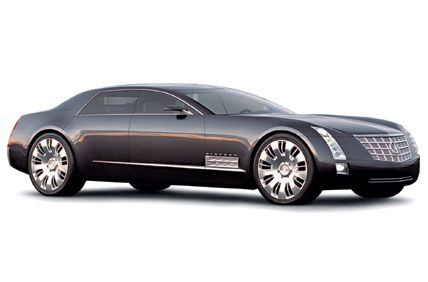Rumors abound on the internet these days that General Motors has given the green light to a Zeta platform based replacement for the Cadillac DTS and STS and for the Buick Lucerne. The platform, which is first to be used for the upcoming Chevrolet Camaro and is the basis for the current Pontiac G8 produced in Australia, will be rear wheel drive. A single car will replace both of the current Cadillac models.
That’s the story, anyway. GM, of course, does not comment on future product plans.
But, let’s assume the rumor to be true, partly because it makes sense and partly because it is pleasant to assume to be true that which one wishes to be true.
It does, incidentally, make sense. Though GM has made it clear that it is selecting front wheel drive over rear wheel drive for future models, in the near-term it does not have to meet the ultimate level of fuel economy demanded by the new CAFE regulations. Those aren’t fully implemented until 2020. Until then, it still has to sell cars and it already has a huge investment in the Zeta platform. It needs to recoup that investment. Anyway, if it can actually get the Volt into production and sell it in the contemplated volume, it’s going to have some latitude under the CAFE cap.
Moreover, of course, GM is positioning Cadillac as an international luxury brand. To meaningfully compete in that market, it takes a rear wheel drive large luxury car.
But, it also takes a V-8 and General Motors has publicly announced that it has cancelled its planned successor to the Northstar V-8 currently used in the DTS, STS, and top-of-the-line Lucerne.
So, assuming the rumor to be true,
What’s the engine going to be?
There have been suggestions that a turbocharged version of the direct injection V-6 used in the CTS would find its way under the hood of the new large car. Others have suggested that Cadillac is going to have to go to diesel power, just as have several of the German marques. And, of course, there’s the small-block Chevy that’s already used in the G8 and will be used in the Camaro. Cadillac has used Chevy power before, in the CTSv.
None of those possibilities, though, is a good fit for the large, rear-wheel drive luxury car that GM is apparently intending to produce.
A V-6, even with turbocharging, simply isn’t comparable to a V-8, even if the power output is the same. Almost from the invention of the automobile, more cylinders has equated to more prestige and status. Buick tried to compete with V-6 power for a number of years. That is one of the reasons the brand now needs to be resuscitated.
Diesel power doesn’t seem like the answer, either. When I spoke with Jim Taylor, the General Manager of Cadillac, at the North American International Auto Show, he pointed out that diesel emissions standards in Europe and the United States are very different. (That’s one of the reasons that Mercedes-Benz initially missed compliance with California’s standards when it introduced a new diesel SUV last year.) Cadillac could build a diesel for the European market with technology already employed there by Opel, GM’s German subsidiary. But that technology would not work for the United States market.
Nor does a version of the small-block Chevy seem the answer. The international prestige General Motors seeks for Cadillac cannot be achieved with a pushrod engine shared with trucks.
That leaves one tantalizing possibility:
A V-12 version of the direct injection V-6 currently used in the CTS.
Would GM cancel a V-8 successor to the Northstar and then build a V-12.
Yes. Why not? In fact, it makes complete sense for them to do so. GM cancelled the new V-8 right at the point when they were going to have to start spending real money on it: at the point of ordering the tooling to make it. If GM concluded that they had a better engine on the near horizon, wouldn’t it make complete sense to keep the Northstar in production a few years longer, while simultaneously accelerating production of the development engine?
There are reasons to believe that is precisely what GM has done. The cancelled V-8 was not a direct injection engine. A V-12 based on the CTS V-6 would be direct injection, which makes it much easier to manage emissions and fuel economy. Moreover, it’s believed that such an engine has advanced sufficiently to be, according to some reports, seen undergoing road testing in Holden Commodore mules in Australia. Deriving a V-12 from the existing V-6 likely means that some components can be shared, further reducing development and tooling costs. Lastly, add in some newer technology, such as cylinder deactivation and variable valve timing, and there’s no reason that a V-12 cannot be at least as economical as a V-8, and achieve reduced emissions in the process.
A V-12 Cadillac.
Don’t you think Bob Lutz would just love to do that?

